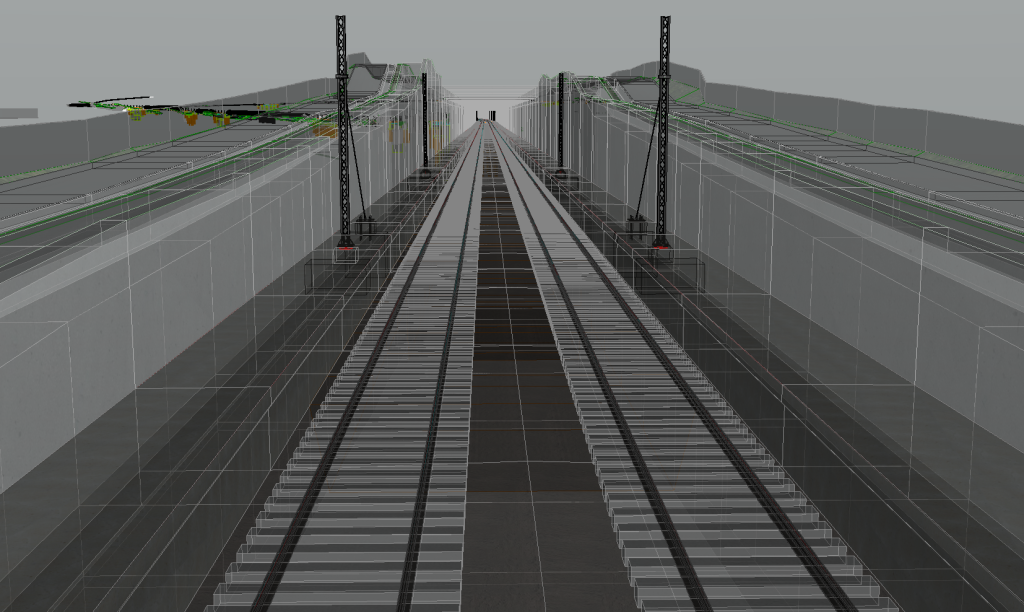Originally written by Julien Moutte, Chief Technology Officer, Bentley Systems, on railway, sustainability, and more…
In global initiatives to combat climate change, increased investment in public transportation—particularly rail—is widely touted as a sustainable pathway towards emission reduction and climate mitigation. According to a recent UN report, shifting to trains and buses may reduce greenhouse gas (GHG) emissions by two-thirds per rider, per kilometer. At the same time, expanding public transport infrastructure service coverage and capacity offers communities an array of economic and social benefits, including wider access to employment and education, lower rates of traffic fatalities, and better local air quality than in automobile-dense areas. In short, the shift back to rail—the two-centuries’ old solution that predates personal cars by 100 years—should seem like an obvious step. Why wouldn’t everyone, as they say, just get on board?
Yet, over the past quarter century, Europe has been doing the opposite. Investment in motorways has gone up 60%, while investment in rail networks has declined by 6.5%, resulting in the dismantling of local and regional rail networks and the closure of thousands of stations across the continent.
While this trend is starting to reverse, rail investment is still hampered by problems, such as cost inefficiency, competing national interests, and fragmented networks—to say nothing of the complexity of repairs and new construction on systems that have suffered poor maintenance and insufficient development over the past decades.
How can railway network owners get things back on track? Leveraging new digital infrastructure capabilities, particularly digital twins, may help to offer a way forward, allowing optimization of rail infrastructure investments to build faster, cleaner, and more resilient transportation networks for both passenger and freight.
Harmonizing Disparate Data and Systems
While many people are only aware of digital twins as visual representations of real-world assets and processes, data aggregation and interoperability are among their most useful capabilities. Infrastructure digital twins can connect data and processes from disparate applications or systems and merge them into one unified system that uses a standard format. Digital twins can get these data to “talk to each other” and analyze how different sources may impact one another.
By facilitating real-time data ingestion and processing (that is, incorporating data from disparate sources as it arrives), infrastructure digital twins can capture and connect Europe’s entire railway network to prioritize brownfield and greenfield infrastructure projects. This process can give stakeholders across the continent a single source of truth for millions of data points, offering the potential for efficient, effective, and collaborative workflows across all constituent rail networks and their respective information technology, engineering technology, and operational technology (IT, ET, and OT) systems.

Simulation For Repairs and Updates
Maintenance and improvements across rail networks are ongoing challenges. By using infrastructure digital twins, owner-operators can apply artificial intelligence (AI) and machine learning (ML) algorithms to analyze real-time telemetry or imagery/sensor data and perform anomaly detection. AI can also analyze rail operational data and provide alert notifications to assess and address network issues and failures. Infrastructure digital twins can also be leveraged in a predictive capacity. Using historical repair data, weather data, capacity information, utilization levels, passenger or freight flows, and geophysical data, AI and ML algorithms can suggest what repairs or updates are or will be needed, when, and how best to accomplish them.
Data and insights from infrastructure digital twin simulations could help rail operators analyze maintenance and improvement impacts–how a planned maintenance event would affect certain routes and services, what potential cost or resource constraints may be encountered, or what environmental effects may be incurred as a result. Built-in decision support systems can help stakeholders optimize planning for these updates, factoring in and reconciling disparate information about cost, safety, environment, and system performance that might have been previously impossible to integrate into these decisions.
Carbon Calculation
With the focus on mitigating climate change, models with embodied carbon capabilities—that is, those with a built-in function to help stakeholders calculate carbon emissions and cost for their project or asset—are more necessary than ever. The reason for this is obvious: GHG emission is a ship that we can’t right once it’s capsized.
Infrastructure digital twins can facilitate carbon calculation throughout the lifecycle of an asset, whether it’s being designed, built, used, maintained, or decommissioned. Data from these models can influence stakeholders’ choices from the ground up, such as choosing less emissive materials in construction, such as stone over cement. They can also calculate both the carbon cost of a proposed change or the cost of not making that proposed change, allowing stakeholders to evaluate an array of scenarios. Ultimately, the carbon capabilities of digital twins enable infrastructure decisions that optimize cost, efficiency, and climate mitigation.

Optimized Productivity
Realistically, the pressure to invest in rail networks is not going to dissipate. Rather, the need to invest will become increasingly urgent, as climate conditions degrade and the targets that have been defined in the UN COPs become harder and harder to reach. Engineering firms and owners-operators will face a deluge of work to be done, much of it backlogged, to repair and improve existing lines, build out connection points between countries, reopen lines that had been decommissioned due to a past preference for highways, and operate and maintain all of these assets. The work will be time and labor intensive, not to mention costly.
Infrastructure digital twins and digital tools powered by AI will be necessary to help manage all this work, at every stage of project lifecycles, from design or redesign, to building and repairing, to utilizing these assets. Engineering firms and other stakeholders can leverage digital twin capabilities to work collaboratively, optimize workflow and resources, predict and resolve problems, and ultimately close the gap between as-designed and as-built, yielding more resilient and sustainable rail assets.
A Focus on Sustainability
The adverse impacts of climate change on our transportation systems—from dried-up rivers and canal beds, to destabilized roads as a result of historic flooding, to storm-damaged ports and coastal cities—require us to make drastic and immediate changes to the ways we move people and goods across Europe. In this respect, our economic and environmental goals are powerfully aligned, and more urgent than ever.
But technology is on our side. Emerging infrastructure digital twin capabilities can help modernize and transform rail networks that are badly in need of refurbishment and enable us to build different and better infrastructure in the future. State-of-the-art, sustainable infrastructure can help us to meet the complex needs of our increasingly globalized era and improve our quality of life to the greatest extent possible.

